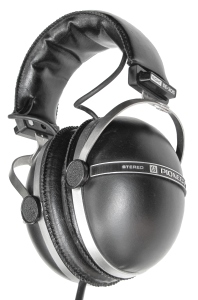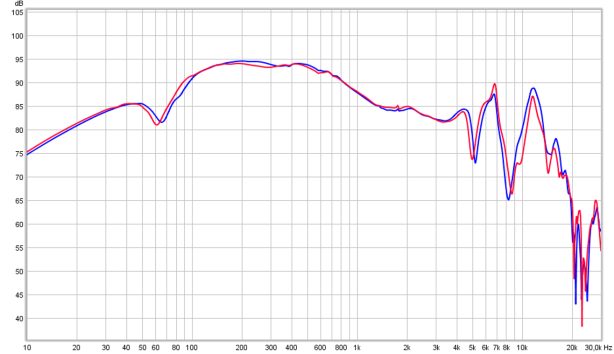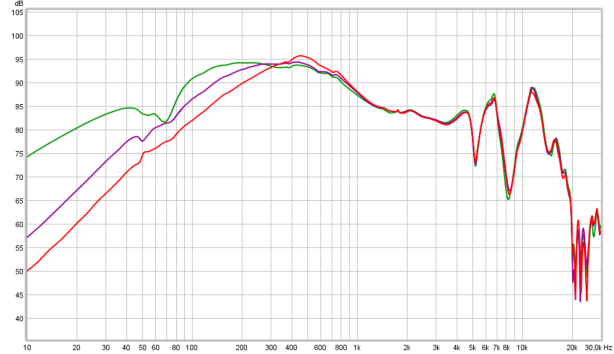SE-305
published: Aug-25-2018
NO SMOOTHING is applied to the shown plots. Most measurement sites have some smoothing applied which ‘irons flat’ sharp peaks and ‘wiggles’. I do not use smoothing because some info about sound quality is lost when plots are smoothed.
Aside from a small correction of the microphone itself also some correction in the lowest frequencies is applied to the plots to compensate for the perceived loss of bass when using headphones. This is described HERE in more detail.
A ‘horizontal‘ frequency response curve on the shown frequency response plots on this website thus indicates a perceived ‘flat’ tonal signature.
ALL measurements are made with a good SEAL on a flatbed measurement rig.
The shape of your head, bone structure, pad size, pad ‘softness, (compliance), hair or no hair and or wearing glasses may (drastically) change the frequency response of some headphones, so… your personal experience may differ substantially from these plots.
Frequency response (tonal balance) is the most sound-determining aspect of headphones. A horizontal line shows audible neutral response in the plots on this website. Deviations in different severities at different frequency bands have an effect on the sound character.
The bigger the deviation the stronger the effect.
Below an aid to help determining the sound character of headphones with relation to the frequency response.

Pioneer SE-305

The Pioneer SE-305 is headphone that was first produced in 1972. It stayed in production for many years. It was the more expensive sibling of the SE-205 .
It was nicknamed ‘the coconut’ for obvious reason and pretty popular.
This is a closed headphone and a heavy one as well. It had a coiled cord and was intended for home and studio usage. The build quality is good and the main reason many of these still exist today.
 The headband and pads are made of leather. The pads are shallow. This may be quite uncomfortable for those with protruding ears. These pads are formed asymmetrically and are removable.
The headband and pads are made of leather. The pads are shallow. This may be quite uncomfortable for those with protruding ears. These pads are formed asymmetrically and are removable.
Your Pinnae will be touching a piece of foam. The foam in this headphone is still original and surprisingly still in perfect state after about 40 years !
The clamping force is medium.
Height is adjustable over a wide range. These should fit most heads.
The cord is coiled and can be stretched to 5m long. It has a nickel plated 6.3mm TRS jack and is non-replaceable. There is a single entry on the left cup. There is a small cable running in the headband to the other cup.
 The cups are also covered with leather and has a thin layer of foam underneath.
The cups are also covered with leather and has a thin layer of foam underneath.
Steel is used througout as well as durable hard plastic. Inside the cups there is also some damping foam. This too is still in good condition.
The driver itself is quite low impedance. This is quite unusual for those days as most drivers were much higher. 
The driver measures 10Ω resistance but is specified as 8Ω. It has a diameter of 45mm but the membrane itself is 41mm. The biggest part of the membrane is covered. There are some small holes in a large circle. Those holes are covered with foam. A small part in the middle (22mm) is open.
One would expect that such a driver would have a varying impedance but this is not the case. This is a good thing as most amplifiers/receivers in those days had a rather high output resistance. In most cases the headphone out was simply the amplifiers speaker output with an added resistance.
Some amplifiers even had output resistors as high as 300Ω.
Because of the SE-305’s low and flat impedance this headphone sounded very similar on most amplifiers.
How does this headphone compare to modern headphones. One would expect some leaps have been made in the past 45 years.
specifications:
Type: Over ear, closed
Isolation: average
Usage: Home, studio
Driver type: dynamic
Pads: Leather
Foldable: No
Headphone cup connector: fixed cable
Cable entry: single sided (left)
Cable: 5m, 6.3mm TRS coiled cable
Driver size: ∅ 45mm (membrane 40mm)
Max. power rating: 0.5W
Max. input voltage: 2V rms
Max. drawn current: 250mA
Max. S.P.L.: 122 dB
Impedance: 10 Ω
Efficiency: 95dB @ 1mW
Sensitivity: 116dB @ 1V
Weight: 435 g.
Clamping force: medium.
Accessories: travel case, manual.
Sound description:
Bass does not reach down deep but is still present. Mid bass is decent and integrates nicely with the mids. Mids do not have great clarity but still have some open-ness. The mids are not ‘muffled’. They just lack ‘bite’ and ‘attack’. Upper mids and treble are subdued compared to the lower mids and bass. Treble lacks subtleties and is course but not ‘grainy’. It lacks nuances and ‘air’.
It does not have a ‘Hi-Fi’ sound character.
Basically this headphones is mostly about upper bass and lower mids.
It can still function well as a monitor for which it is quite well suited. Piano music is also something this headphone works well with. Voices and acoustic guitar also sounds decent. Just a bit ‘laid back’ and ‘distant’ but with decent dynamics.
Older recordings of the Rolling stones sound quite decent and dynamic on this headphone.
Sound quality wise it is no match for the even the cheapest Sennheiser headphones like the HD201 etc.
Measurements:
Below the frequency response of the SE-305 (Left, Right)
Channel matching is excellent. It seems like it wasn’t a big problem to produce drivers with closely matching properties that many years ago already.
Bass extension is decent but not on the same level as the upper bass. At 30Hz it is reproduced at about half the level (-10dB) opposite the upper bass/lower mids.
From 600Hz to 1.2kHz it drops -10dB again and then stays at that level till about 12kHz.
From 4kHz the to 13kHz the treble response is a bit jagged. This is responsible for the treble lacking ‘fidelity’ and ‘finesse’. The upside is that there is also no sibilance and one can play these headphones a bit louder without becoming shrill and harsh.
Seal
Getting a good seal is important for closed headphones. This headphone is no exception.
Due to the pads being shallow and not very supple getting a seal may be a challenge for some people.
Below the Right channel is shown. Perfect seal, wearing glasses with ‘thick’ arms, bottom part of the pad slightly lifted so loss of seal.
As can be seen a good seal is important for the amount of bass. Wearing thin armed (reading) glasses does not affect the tonal balance that much. When using thicker armed glasses the bass becomes audibly less. The sound becomes ‘thinner’ and gets a ‘cuppy’ character.
When a substantial loss of seal is reached the sound looses all ‘body’ and is very ‘cuppy/hollow’ sounding.
output resistance / damping-factor
As this is a dynamic headphone the frequency response might be amplifier output resistance dependent when certain higher output resistance amplifiers are used.
To test this the headphone is measured via a low impedance amplifier (0.2Ω) and a high impedance amplifier (120Ω). On a higher output resistance amplifier the output level will be considerably lower. To compensate for this the amplifier is cranked up to the same level (22dB at 1kHz) as the low impedance amplifier. This way the plots are overlay-ed and it is easy to see how the tonal balance changes.
The SE-305 isn’t really sensitive to a higher output resistance amplifier. Even at 120Ω there is only a 3dB boost in the upper treble due to the inductance of the voicecoil.
At a higher output resistance the upper treble thus gets a small boost but the overall level is a lot lower. This ensures noise from power amplifiers is effectively lowered when higher output resistances are used.
Below the distortion measurements of the SE-305 (Right channel). The plot above shows the level differences (in dB) between the signal and the harmonics. Most people prefer to see percentages instead of level differences so below the exact same plot except ‘normalised’ to the actual signal and level differences given in percentages.
The plot above shows the level differences (in dB) between the signal and the harmonics. Most people prefer to see percentages instead of level differences so below the exact same plot except ‘normalised’ to the actual signal and level differences given in percentages. Distortion levels are impressively low above 50Hz. Around 2% 2nd harmonic distortion around 40Hz isn’t a problem. This is to be expected from smaller (40mm) drivers at this level (90dB SPL). The 3rd harmonic (which indicates clipping alike sound) fortunately is below 0.1% above 50Hz
Distortion levels are impressively low above 50Hz. Around 2% 2nd harmonic distortion around 40Hz isn’t a problem. This is to be expected from smaller (40mm) drivers at this level (90dB SPL). The 3rd harmonic (which indicates clipping alike sound) fortunately is below 0.1% above 50Hz
- The actual 2nd harmonic distortion above 300Hz may well be lower than 0.1%. A shortcoming of my measurement rig.
Above 100Hz the distortion is quite good. Below 100Hz higher distortion numbers are not really as detrimental to sound quality as above it so the SE-305 sperforms quite good with resect to distortion.
Time domain
Below the CSD (waterfall) plot of the SE-305. Left and Right are overlaid. Around 7kHz there is a resonance. This is smack in the middle of the ‘sibilance area (6-8kHz). Because the level is not elevated that much there isn’t an audible amount of sibilance. The dip at 9kHz and following peak around 12kHz are an indication of poor treble quality.
Around 7kHz there is a resonance. This is smack in the middle of the ‘sibilance area (6-8kHz). Because the level is not elevated that much there isn’t an audible amount of sibilance. The dip at 9kHz and following peak around 12kHz are an indication of poor treble quality.
Below the spectrum plot of the SE-305 (Right channel). This basically is a CSD (Waterfall) plot but viewed from above where the level differences are colour coded instead of being in the vertical axis and go a lot ‘deeper’ than the CSD.
Also the frequency range of the spectrum plot is wider (from 100Hz instead of 500Hz). The time span is also bigger in the spectrum plots and expired time is shown from below to top where in the CSD the time is shown from rear to front. The bass does not linger on too much which is a good thing. There is something strange around 2kHz where the driver seems to have a (low level) resonance that is not seen in the CSD. That ringing is about 45dB to 50dB below the initial signal so I don’t think it degrades the sound though as it is low in amplitude and narrow in bandwidth.
The bass does not linger on too much which is a good thing. There is something strange around 2kHz where the driver seems to have a (low level) resonance that is not seen in the CSD. That ringing is about 45dB to 50dB below the initial signal so I don’t think it degrades the sound though as it is low in amplitude and narrow in bandwidth.
Below the step response of the SE-305 (Right channel)
This plot shows very little ringing. It does not have great bass extension as shown by the early drop in the signal level. The initial rise does not reach the 0dB line at all. This shows the poor HF response of this driver. This alongside the peak around 0.6ms and the early bass roll-off show this headphone has a ‘lower mids’ oriented sound signature.
Below squarewave and 100μs impulse measurements.
The 40Hz oscilloscope shot shows there is no bass extension to speak off.
The measured 440Hz signal looks more like a sinewave than the applied signal. This shows the lower mids emphasis of this headphone (basically subdued bass and upper-mids/treble area)
The 100μs signal is not reaching the desired level at all but does not show any over- nor under-shoot and even though some resonance is visible the amplitude is small.
summary
This Pioneer SE-305 is a very old headphone. It is in a remarkable good condition after so many years (approx. 40 years). It measures acceptable in some areas but not so great in others.
This headphone is not really comparable with more modern headphones. Back in the days it was considered a good consumer level headphone.
A fun and nicely built headphone, perhaps with sentimental value but not so great any more in sound quality.
Some recordings, however, did sound quite nice/good such as the older Rolling Stones stuff. When you are a fan and can get a good condition headphone for $5 to $20 it can give you a fun retro experience.
